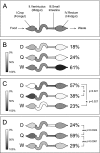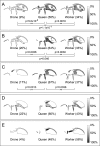Honey bee protein atlas at organ-level resolution
- PMID: 23878156
- PMCID: PMC3814894
- DOI: 10.1101/gr.155994.113
Honey bee protein atlas at organ-level resolution
Abstract
Genome sequencing has provided us with gene lists but cannot tell us where and how their encoded products work together to support life. Complex organisms rely on differential expression of subsets of genes/proteins in organs and tissues, and, in concert, evolved to their present state as they function together to improve an organism's overall reproductive fitness. Proteomics studies of individual organs help us understand their basic functions, but this reductionist approach misses the larger context of the whole organism. This problem could be circumvented if all the organs in an organism were comprehensively studied by the same methodology and analyzed together. Using honey bees (Apis mellifera L.) as a model system, we report here an initial whole proteome of a complex organism, measuring 29 different organ/tissue types among the three honey bee castes: queen, drone, and worker. The data reveal that, e.g., workers have a heightened capacity to deal with environmental toxins and queens have a far more robust pheromone detection system than their nestmates. The data also suggest that workers altruistically sacrifice not only their own reproductive capacity but also their immune potential in favor of their queen. Finally, organ-level resolution of protein expression offers a systematic insight into how organs may have developed.
Figures







References
-
- Cox J, Mann M 2008. MaxQuant enables high peptide identification rates, individualized p.p.b.-range mass accuracies and proteome-wide protein quantification. Nat Biotechnol 26: 1367–1372 - PubMed
Publication types
MeSH terms
Substances
LinkOut - more resources
Full Text Sources
Other Literature Sources
